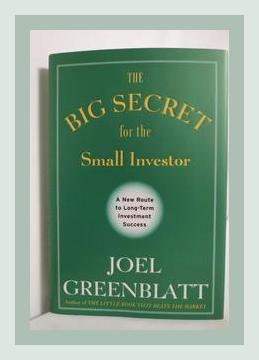Finance and AccountingInvestment Strategies
The Big Secret for the Small Investor by Joel Greenblatt: A Summary
Joel Greenblatt’s “The Big Secret for the Small Investor” focuses on simplifying investment strategies for the everyday investor, providing practical advice on how to approach investing in a way that balances risk and reward safely and effectively. Below is a structured summary highlighting the main points and actionable steps derived from the book.
Introduction
Greenblatt begins by explaining the necessity to democratize investment knowledge that has traditionally benefited only large investors or financial institutions. He emphasizes that individual, small investors can achieve significant returns without needing the financial sophistication of Wall Street elites.
Major Points and Actionable Steps
1. Understanding the Stock Market
Point
Greenblatt starts by explaining the dynamics of the stock market, stressing the inherent volatility and unpredictability. He highlights that many small investors often make the mistake of trying to time the market or pick individual winners without a solid strategy.
Example
He points out the frequent retail investor behavior of buying high in exuberant bull markets and selling low in the despair of bear markets, thus losing money.
Actionable Step
Step: Diversify.
Instead of trying to time the market, Greenblatt suggests small investors should focus on buying a diversified basket of stocks. This reduces risk and exposure to individual stock volatility. Index funds, which track market indices, are a great starting point for diversification.
2. The Magic Formula
Point
One of Greenblatt’s key contributions is the “Magic Formula,” which identifies stocks that are “good” (generating high returns on capital) and “cheap” (traded at an attractive price).
Example
Greenblatt uses historical data to demonstrate that stocks fitting the Magic Formula criteria have consistently outperformed the market averages over extended periods.
Actionable Step
Step: Adopt the Magic Formula.
Greenblatt provides a specific formula: rank companies by high earnings yield and high return on capital. Create a portfolio of 20-30 stocks that consistently rank highly according to these criteria and hold them.
3. Long-term Investment Perspective
Point
Greenblatt underlines the power of compound interest and advocates for a long-term investment horizon. He argues that while short-term market movements are unpredictable, the value of disciplined, long-term investing cannot be overstated.
Example
He illustrates this with the example of famous long-term investors like Warren Buffet, who achieved greatness through patience and consistency over decades.
Actionable Step
Step: Commit to Long-Term Holding.
Small investors should commit to holding their investments for a minimum of 3 to 5 years. This effort minimizes the impact of short-term volatility and allows the compound growth effects to take hold.
4. The “Low-Cost Index Fund” Strategy
Point
For investors unwilling or unable to devote time to stock picking, Greenblatt recommends low-cost index funds as a viable option. Index funds passively track a market index, embodying the benefits of diversification at a low cost.
Example
He references research showing that most actively managed funds fail to outperform their benchmark indices after fees, making index funds a superior alternative for long-term investors.
Actionable Step
Step: Invest in Low-Cost Index Funds.
Invest a significant portion of one’s portfolio in low-cost index funds such as those tracking the S&P 500. Vanguard and Fidelity offer a variety of such funds with extremely low expense ratios.
5. Value Investing Principles
Point
Greenblatt encourages investors to embrace value investing principles. This involves buying securities that appear underpriced by some form of fundamental analysis.
Example
He mentions Benjamin Graham and his teachings on value investing, particularly focusing on the concept of “margin of safety” by purchasing stocks well below their intrinsic value.
Actionable Step
Step: Conduct Fundamental Analysis.
Investors should focus on understanding the intrinsic value of companies by analyzing financial statements and business models. Websites like Morningstar provide valuable tools for conducting such analysis.
6. The Role of Psychology in Investing
Point
Greenblatt discusses how investor psychology, including emotions like fear and greed, often leads to poor decision-making. Behavioral finance plays a significant role in investor success.
Example
During market downturns, many investors panic and sell at the lowest points, only to miss out on the recovery. Conversely, during bubbles, greed drives poor decision-making by overpaying for stocks.
Actionable Step
Step: Maintain Discipline and Objectivity.
Develop a well-thought-out investment plan and stick to it regardless of market sentiment. This may involve setting predefined rules for buying and selling, independent of emotional impulses.
7. The Importance of Education and Continuous Learning
Point
Greenblatt emphasizes the importance of continuous learning and education in improving investment acumen. He advises small investors to read extensively and stay updated with financial news and literature.
Example
He cites his own experiences and how reading extensively on different companies, market strategies, and financial theory has helped him refine his investment approach.
Actionable Step
Step: Commit Time to Education.
Dedicate at least one hour per week to investment-related reading. Books like “The Intelligent Investor” by Benjamin Graham, articles from financial journals, and reputable news sources should be part of regular study.
Conclusion
“The Big Secret for the Small Investor” serves as a comprehensive guide aimed at empowering individual investors with manageable and effective strategies. Greenblatt’s advice balances complex financial insights with practical, actionable steps that simplify the path to successful investing. By embracing diversification, adhering to the Magic Formula, committing to long-term investment horizons, utilizing low-cost index funds, practicing value investing principles, remaining disciplined against psychological biases, and maintaining a continuous learning regime, small investors can significantly enhance their chances of achieving superior investment returns.
Summary
Greenblatt’s book is an invaluable resource that breaks down sophisticated investment concepts into digestible and actionable strategies for investors irrespective of their financial acumen or portfolio size. The actionable steps provided in each major point offer a clear roadmap, making the often daunting world of investments more accessible and less intimidating for small investors.
